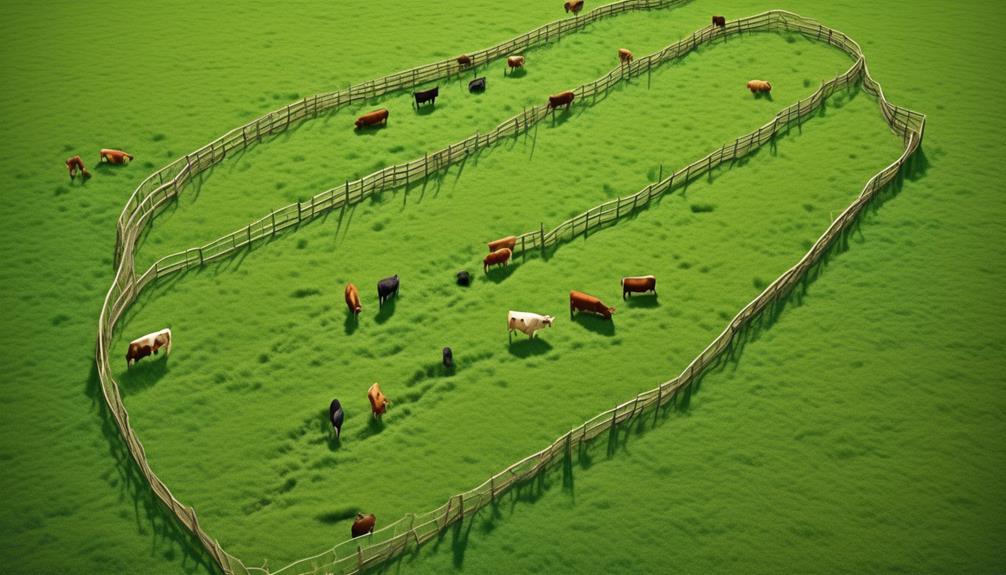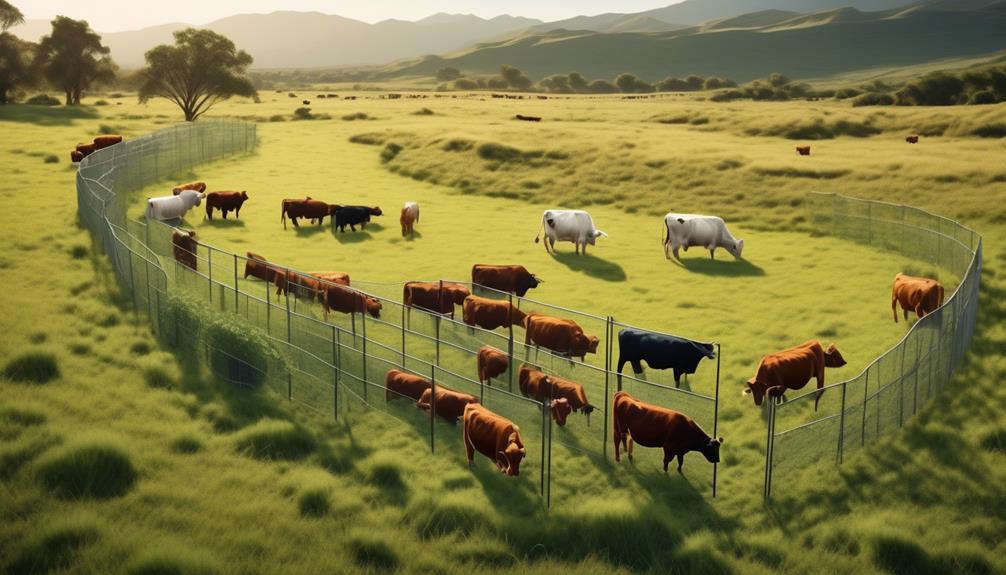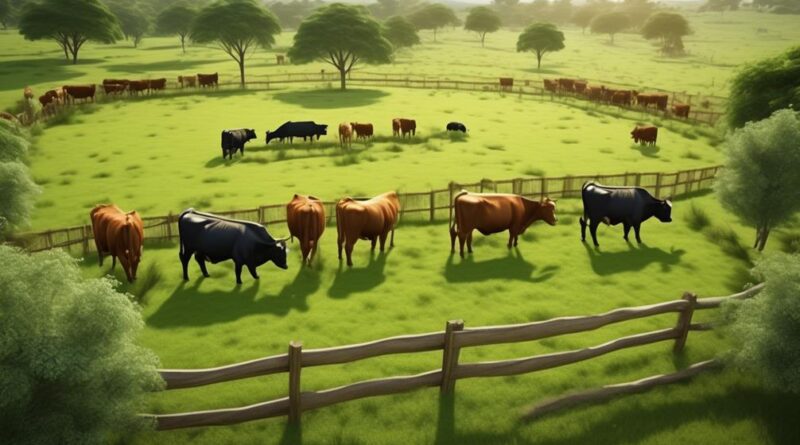3 Best Grazing Rotation Strategies for Cattle Health
You've probably heard of the success stories of ranchers who have implemented adaptive multi-paddock grazing to improve their cattle's health and land productivity.
But did you know that there are two other equally effective grazing rotation strategies that could significantly benefit your herd's health and overall well-being?
These strategies go beyond just moving cattle from one pasture to another and have been proven to enhance cattle nutrition, reduce parasite load, and improve soil health.
If you're looking to optimize your grazing management for the betterment of your cattle and land, these strategies are worth exploring.
Rotational Grazing Basics

Implementing a rotational grazing system can significantly improve forage utilization and cattle health on your farm. Grazing management is crucial for maintaining healthy pastures and ensuring your cattle have access to high-quality forage.
Rotational grazing involves dividing your pasture into smaller paddocks and moving your cattle between them at regular intervals. This strategy allows forage to recover in the ungrazed paddocks, leading to improved pasture quality and increased carrying capacity. By rotating your cattle through different paddocks, you can also manage grazing pressure more effectively, preventing overgrazing and soil compaction.
Pasture improvement is a key benefit of rotational grazing. As your cattle move through the paddocks, they deposit manure, which acts as a natural fertilizer, enhancing soil fertility and promoting healthy grass growth. Additionally, giving the forage plants time to rest between grazing periods allows them to regrow vigorously, leading to lusher pastures with a greater diversity of plant species. This not only benefits your cattle by providing a more nutritious and varied diet but also contributes to overall pasture health and resilience.
Effective grazing rotation requires careful planning and monitoring. You'll need to consider factors such as stocking density, paddock size, and rest periods for each paddock. Regularly assessing your pastures and adjusting your grazing management plan accordingly will help you optimize forage utilization and maintain healthy pastures for your cattle.
High-Intensity Grazing
To maximize forage utilization and further improve cattle health, consider adopting a high-intensity grazing approach on your farm. High-intensity grazing, also known as intensive management or management-intensive grazing, involves dividing pastures into smaller paddocks and moving cattle frequently, often daily or even multiple times a day. This method aims to maximize pasture utilization, allowing forage to be grazed evenly and preventing selective overgrazing. By intensively managing your pastures, you can optimize forage production and quality, leading to improved cattle nutrition and overall herd health.
Implementing high-intensity grazing offers several benefits. Firstly, it allows for better control over grazing pressure, ensuring that pastures aren't overgrazed and promoting regrowth. This practice also encourages more uniform grazing across the entire pasture, which can lead to improved forage utilization. Additionally, by moving cattle frequently, manure distribution becomes more even, benefiting soil fertility and overall pasture health.
Furthermore, high-intensity grazing can contribute to parasite control by reducing the exposure of cattle to parasite larvae present on the pasture. This approach may also lead to better weight gains in cattle due to improved forage quality and increased grazing efficiency.
Adaptive Multi-Paddock Grazing

Adopting adaptive multi-paddock grazing can revolutionize your cattle management practices, enhancing both pasture health and overall herd productivity. This grazing management strategy involves dividing a pasture into multiple smaller paddocks and rotating cattle through them in a carefully planned manner. Here's why you should consider implementing adaptive multi-paddock grazing:
- Enhanced Pasture Health
- By allowing for longer recovery periods between grazing sessions, this approach promotes healthier pastures with improved grass vigor and root development.
- The rotational system also reduces soil compaction and erosion, leading to better water infiltration and nutrient cycling.
- Reduced Environmental Impact
- Implementing adaptive multi-paddock grazing can help mitigate environmental concerns such as overgrazing and soil degradation.
- This strategy has been shown to increase biodiversity, sequester carbon, and improve overall ecosystem resilience.
Strip Grazing Techniques
Enhancing your grazing management practices, strip grazing techniques involve confining cattle to a narrow strip of pasture for a limited time before moving them to a new section. This method offers several benefits, particularly in managing soil fertility and forage availability.
By controlling the grazing area, you can better manage the impact of cattle on the soil, allowing for more efficient nutrient cycling and improved soil health. Additionally, strip grazing helps to prevent overgrazing and ensures that forage availability remains consistent throughout the grazing period.
Strip grazing can significantly enhance soil fertility by preventing soil compaction and erosion in the grazing areas. As cattle are confined to specific strips for short periods, the rest of the pasture can recover, leading to improved grass growth and root development. This, in turn, enhances soil fertility by promoting organic matter decomposition and nutrient cycling. Moreover, by rotating cattle through narrow strips, you can better distribute manure across the pasture, providing natural fertilization and contributing to soil health.
Furthermore, strip grazing allows for better management of forage availability. By controlling the timing and duration of cattle access to specific sections, you can ensure that forage isn't overgrazed and has sufficient time to recover. This approach maximizes the overall forage yield and nutritional quality, supporting the health and productivity of your cattle herd.
Cell Grazing Methods

Consider implementing cell grazing methods to improve forage utilization and cattle productivity on your pasture. Controlled grazing through cell grazing methods can significantly enhance pasture management, leading to better overall herd health and increased forage production. Here are some key points to consider:
- Enhanced Forage Utilization: By dividing your pasture into smaller cells and rotating cattle through them, you can ensure that forage is utilized more efficiently. This controlled grazing approach prevents overgrazing in certain areas while allowing others to recover, leading to healthier pastures and improved forage availability for your cattle.
- Increased Forage Quality: Through cell grazing, you can promote better forage regrowth and reduce the likelihood of selective grazing, ultimately leading to improved forage quality.
- Cattle Health and Productivity: Implementing cell grazing methods can have a positive impact on your cattle's health and productivity. By providing them with access to fresh, high-quality forage on a rotational basis, you can enhance their overall well-being and boost their productivity.
Incorporating cell grazing methods into your pasture management strategy can be a game-changer for your cattle operation. With a focus on controlled grazing and strategic pasture rotation, you can optimize forage utilization, promote better pasture health, and ultimately improve the productivity of your cattle.
Managed Intensive Grazing
To optimize cattle forage utilization and pasture health, implement managed intensive grazing to strategically rotate your livestock through designated grazing areas. Managed intensive grazing involves dividing pastures into smaller paddocks and rotating the cattle through them at high stocking densities for short periods. This practice can greatly benefit both the cattle and the land by promoting better forage utilization and pasture health.
Grazing density is a crucial aspect of managed intensive grazing. By concentrating cattle in smaller areas for shorter periods, you can ensure that they graze more uniformly, trample less forage, and allow for better recovery of the pasture. This approach also helps to break parasite cycles and reduce selective grazing, resulting in a healthier pasture overall.
Forage management is another key component of managed intensive grazing. By rotating cattle through smaller paddocks, you can control the timing and intensity of grazing, allowing for better forage regrowth. This ultimately leads to improved forage quality and quantity, providing a more balanced and nutritious diet for the cattle.
Time-Controlled Grazing

Time-controlled grazing involves setting specific time intervals for cattle to graze in particular areas, allowing for effective forage management and pasture health. This method is a key component of grazing management and can significantly benefit your herd and pastures.
Here's why time-controlled grazing is a valuable strategy:
- Controlled Stocking: By implementing time-controlled grazing, you can better regulate the number of cattle in specific areas at any given time. This helps prevent overgrazing, allowing the vegetation to recover properly and ensuring a sustainable food supply for your cattle.
- Reduced Soil Compaction: Rotating the grazing areas at specific time intervals helps minimize soil compaction, which can be detrimental to pasture health and regrowth. It also facilitates better water infiltration and nutrient cycling in the soil.
- Enhanced Forage Quality: With time-controlled grazing, you can more effectively manage the grazing pressure on different forage species. This can lead to improved forage quality and diversity, ultimately benefiting the overall nutrition of your cattle.
Incorporating time-controlled grazing into your grazing management plan can lead to healthier pastures, improved forage quality, and better overall cattle health. By strategically implementing specific grazing intervals, you can optimize your pasture resources and contribute to the long-term sustainability of your operation.
Holistic Planned Grazing
Implementing a holistic planned grazing approach can revolutionize your cattle management practices and optimize both pasture health and herd productivity. Holistic planned grazing, a key component of grazing management, focuses on mimicking natural grazing patterns to enhance environmental sustainability. By carefully planning the movement of your cattle, you can significantly improve soil health, increase forage production, and promote biodiversity on your pastures.
One of the fundamental principles of holistic planned grazing is to divide pastures into smaller paddocks and rotate cattle through them at specific intervals. This method allows forage plants to recover after grazing, which in turn prevents overgrazing and promotes healthier pastures. As your cattle graze in a more natural and planned manner, the soil also benefits from improved fertility and water retention, contributing to environmental sustainability.
Additionally, holistic planned grazing encourages strategic rest periods for pastures, allowing vegetation to regenerate and build root mass. This process enhances the overall resilience of the ecosystem and reduces erosion. By integrating these sustainable grazing practices, you can create a more balanced and productive environment for your cattle while preserving the long-term health of your pastures.
Frequently Asked Questions
What Are the Potential Environmental Benefits of Implementing Different Grazing Rotation Strategies for Cattle Health?
When considering grazing rotation strategies for cattle health, the environmental benefits are significant. By implementing these strategies, you can preserve biodiversity, improve soil health, reduce erosion, and promote sustainable land management practices.
How Can Grazing Rotation Strategies Contribute to Improving Soil Health and Fertility?
To improve soil health and fertility management, consider implementing grazing rotation strategies. By rotating cattle across different pastures, you can prevent overgrazing, promote natural fertilization, and enhance the soil's nutrient content, leading to better overall soil health and fertility.
Are There Specific Grazing Rotation Strategies That Can Help Reduce the Risk of Parasites and Diseases in Cattle?
To reduce parasites and prevent diseases in cattle, you should implement effective grazing rotation strategies. Rotating pastures regularly and managing stocking density can help minimize parasite exposure and improve overall herd health.
What Are the Economic Implications of Implementing Various Grazing Rotation Strategies for Cattle Health?
Implementing various grazing rotation strategies for cattle health can have significant economic implications. Conducting a cost analysis is crucial to understanding the profit potential and financial benefits. Different strategies can impact expenses and overall revenue.
How Do Different Grazing Rotation Strategies Impact the Nutritional Quality of the Forage Available to Cattle?
Different grazing rotation techniques significantly impact forage quality, directly affecting cattle nutrition. Forage availability varies with rotational strategies, influencing the nutritional content of the grasses consumed and ultimately impacting the health of your cattle.
Conclusion
So, there you have it – three of the best grazing rotation strategies for maintaining the health of your cattle.
By implementing high-intensity grazing, adaptive multi-paddock grazing, and holistic planned grazing, you can ensure that your cattle have access to high-quality forage while also preventing overgrazing and promoting sustainable land management.
These strategies not only benefit the health of your cattle, but also contribute to the overall health and productivity of your grazing land.
